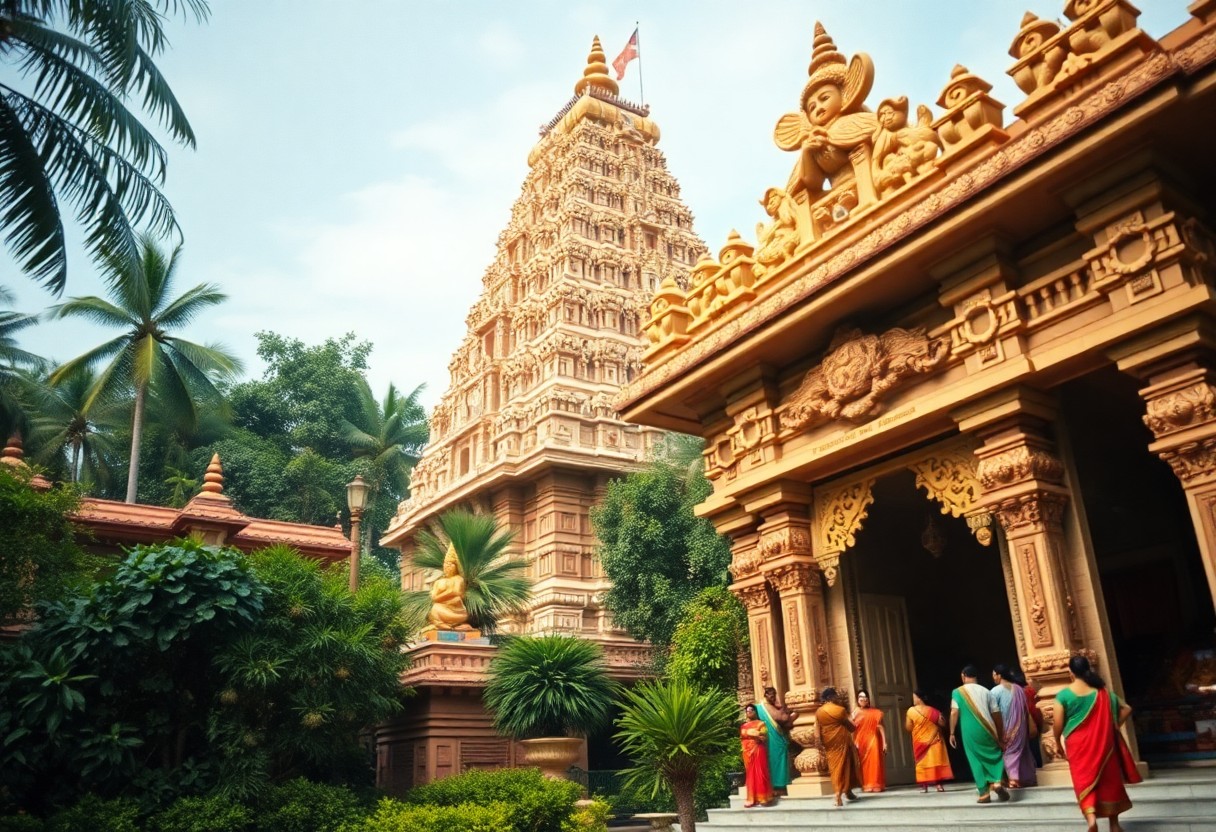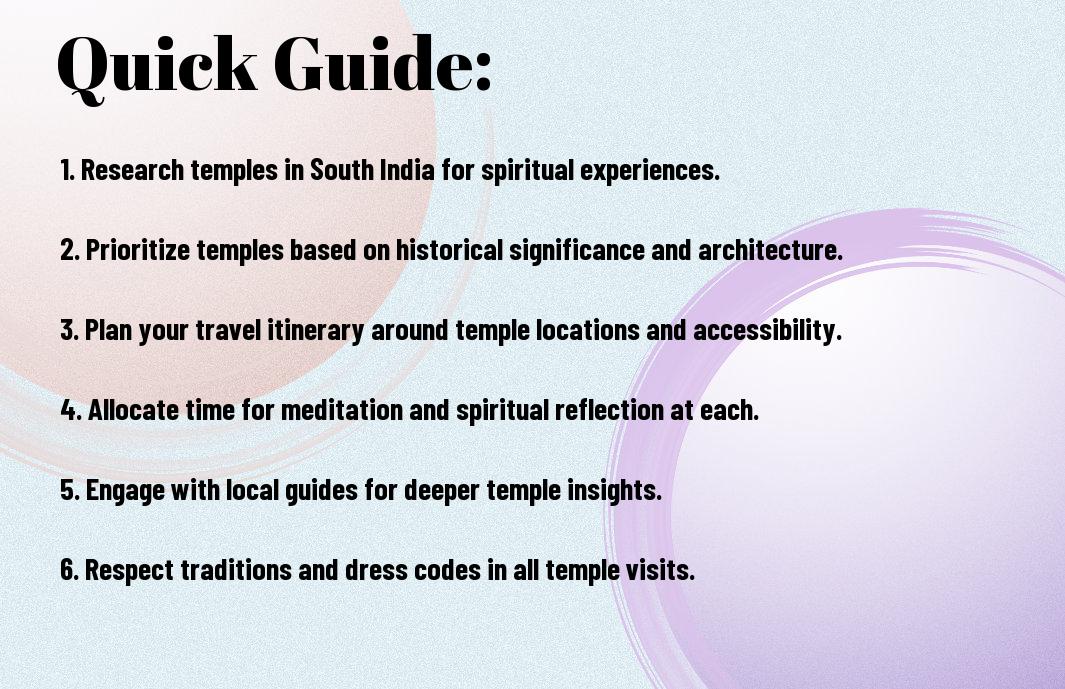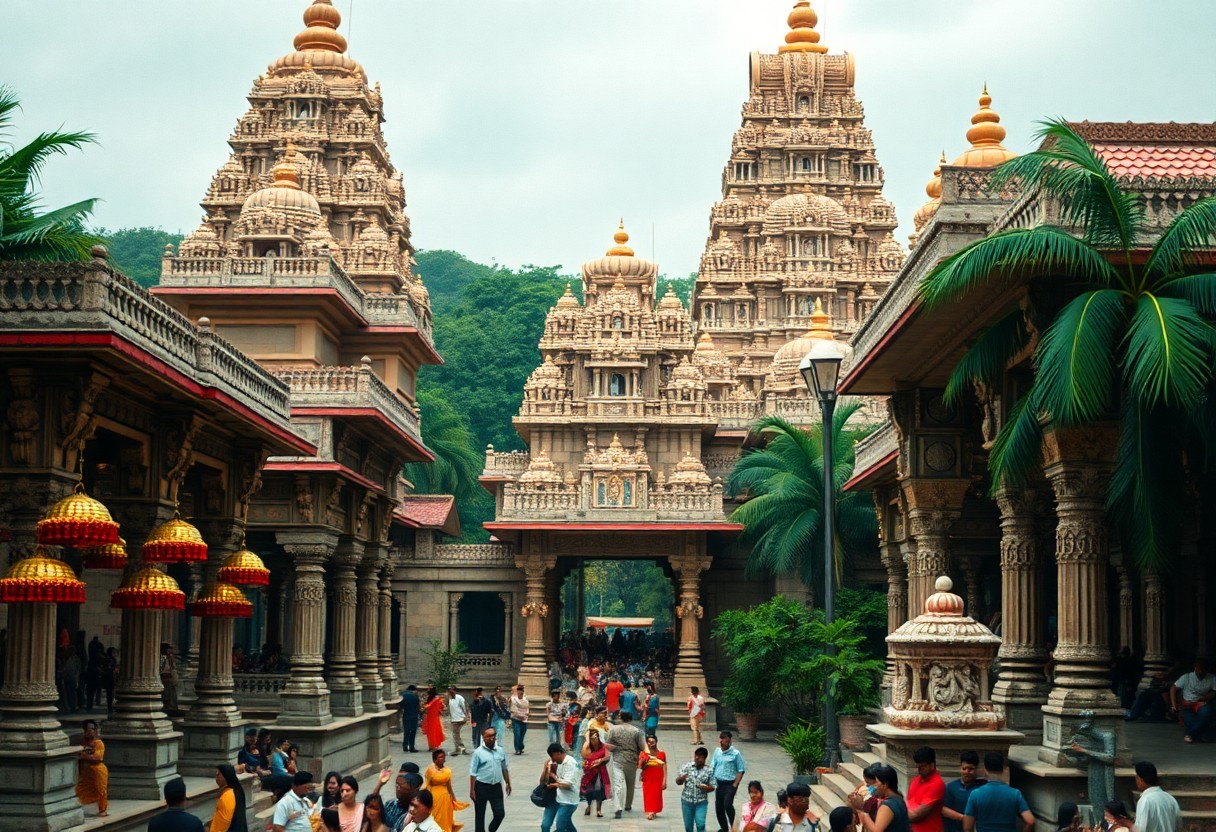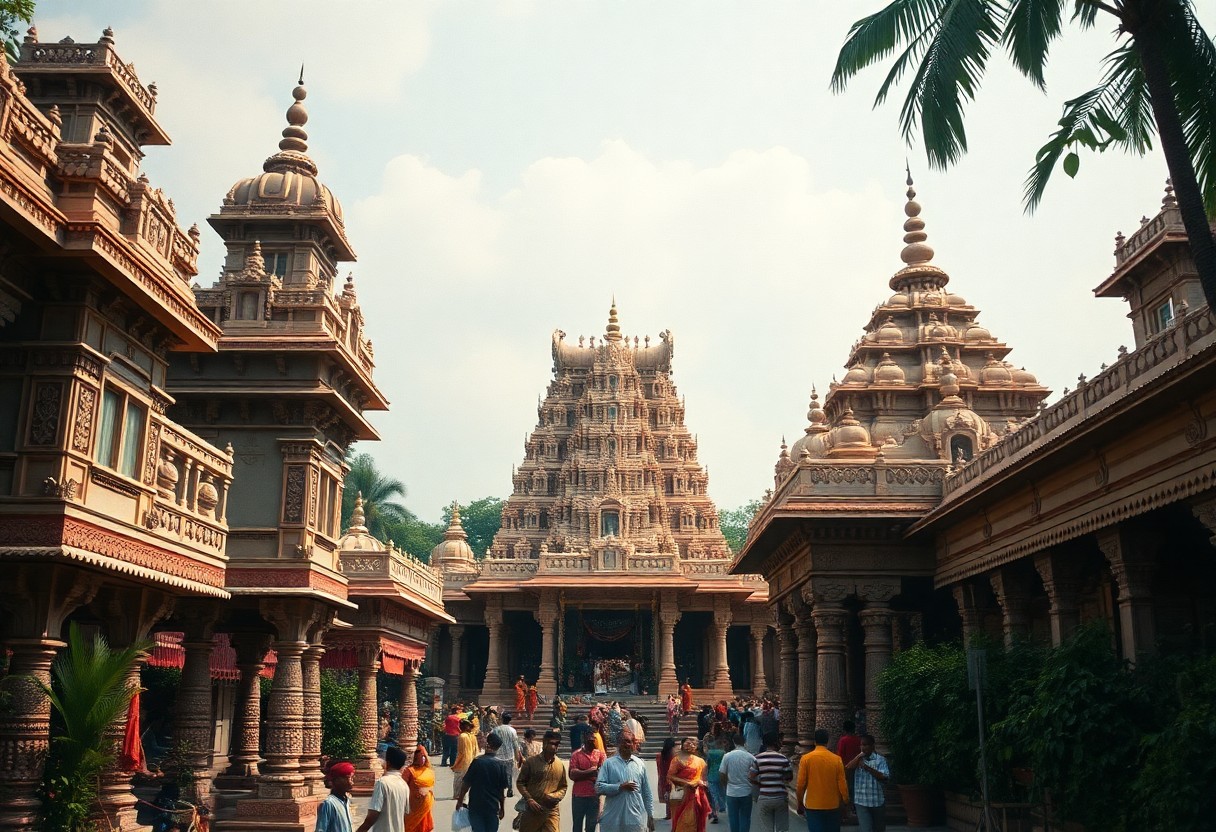Temples in South India are not just places of worship; they are profound reservoirs of history, culture, and spirituality. In my travels, I have discovered that exploring these sacred sites offers a unique glimpse into the rich spiritual tapestry of this region. If you’re seeking a transformative experience, join me as I unveil 15 must-visit temples that will not only inspire your faith but also deepen your understanding of India’s spiritual heritage. Prepare to commence on a journey that nurtures your soul and enriches your travel experiences.
Key Takeaways:
- South India is home to a diverse array of ancient temples, each showcasing unique architectural styles and cultural significance.
- Temples such as Meenakshi Temple in Madurai and Brihadeeswarar Temple in Thanjavur are must-see for their historical and spiritual importance.
- Many temples host vibrant festivals throughout the year, providing visitors with an immersive experience of local traditions and spirituality.
- Travelers can explore the natural beauty surrounding many temples, often set against stunning landscapes that enhance the spiritual experience.
- Visiting these temples offers an opportunity for reflection, meditation, and understanding of South India’s rich religious heritage.

Types of Temples in South India
Before exploring into the captivating world of South Indian temples, it’s crucial to understand the various types that exist. Each temple has its unique significance and purpose, which greatly enriches your spiritual journey. Here are the main categories of temples you will encounter:
|
|
|
|
|
|
|
|
|
The diversity in temple types provides you with a broader perspective on spirituality.
Historic Temples
An necessary aspect of South India’s spiritual heritage is its historic temples. Many of these temples date back hundreds, if not thousands, of years, offering a glimpse into the rich cultural and architectural history of the region. I find it fascinating to explore the stories behind these ancient structures, each telling its own tale of devotion and artistry.
Architectural Marvels
Little do many know that South Indian temples are not only places of worship but also architectural masterpieces. The intricate carvings, towering gopurams (gateway towers), and stunning sculptures leave you in awe of the craftsmanship and dedication involved in their construction.
A visit to these architectural marvels is like stepping back in time. Each temple boasts distinct styles, such as the Dravidian architecture widely found in Tamil Nadu and the intricate stonework seen in Karnataka’s temples. It’s mesmerizing to realize that the designs often reflect the rich heritage of the region and connect you to centuries of devotion and artistry.
Spiritual Retreats
Temples in South India also serve as spiritual retreats, offering a peaceful environment to meditate and reflect. The tranquil atmosphere surrounding these temples allows you to connect with your inner self and seek solace from the chaos of everyday life. I often find myself rejuvenated after spending time in these serene spaces.
South India is home to numerous ashrams and spiritual centers associated with these temples, enhancing your experience further. Many devotees partake in meditation and yoga sessions, creating an immersive spiritual retreat that fosters personal growth and inner peace. Each visit invites you to explore your spirituality in a profound way.


Tips for Visiting Temples
Any visit to temples in South India can be enriching with a bit of preparation. Here are some helpful tips:
- Arrive early to avoid crowds.
- Be mindful of temple timings.
- Ask locals for advice on rituals.
- Respect the sanctity of the space.
Any traveler can enhance their spiritual experience with these small but significant tips.
Dress Code
Dress modestly when visiting temples. Traditional attire such as sarees for women and dhotis or kurta-pajamas for men is often appreciated. I recommend wearing clothing that covers your shoulders and knees, showing respect for the sacred surroundings.
Best Time to Visit
One of the best times to visit temples is early in the morning or during special festivals. These times not only offer a peaceful atmosphere but also a chance to witness vibrant rituals and celebrations. I find that the early hours are especially serene, allowing for reflection and meditation.
Another excellent time to plan your visit is during the winter months, from November to February. The cool weather makes exploring the temples comfortable, and many festivals such as Pongal and Diwali occur during this season, adding to the spiritual ambiance.
Photography Guidelines
With any temple visit, be respectful of photography rules. Many places do not allow cameras or phones inside the sanctum, so I recommend checking the guidelines beforehand. Always ask for permission before taking photos of people or rituals.
A respectful approach to photography can enhance your experience. I’ve found that candid photographs of temple architecture and local rituals can be beautiful, but it’s key to prioritize the sanctity of the space over capturing the moment.
Step-by-Step Guide to Temple Visits
Your journey to spiritual enlightenment at South Indian temples can be enhanced by following a structured approach. Here’s a step-by-step guide to ensure a meaningful visit:
| Step | Description |
| 1 | Planning Your Trip |
| 2 | Arrival and Entry |
| 3 | Engaging in Rituals |
Planning Your Trip
With careful planning, I can make my temple visit a spiritually enriching experience. It’s vital to research the temples that resonate with my beliefs and decide on the best time to visit, as festivals can be particularly vibrant and bustling. I also consider travel logistics, accommodations, and local customs to ensure a smooth journey.
Arrival and Entry
The moment I arrive at a temple, there’s a sense of serenity that envelops me. Each temple has its own customs regarding entry, and I make sure to adhere to these traditions to show my respect. Dress codes often apply, and being mindful of these rules helps me feel comfortable and welcomed.
Understanding the unique entry requirements of each temple enhances my experience. I often find that many temples have designated timings for public visits, and some areas might be restricted to devotees only. Familiarizing myself with these details not only allows me to navigate the space better but also deepens my connection to the sacred surroundings.
Engaging in Rituals
Entry into the temples is just the beginning; I find engaging in rituals to be a profound part of my experience. Whether it’s lighting a lamp, offering flowers, or participating in pujas, each act brings me closer to the spiritual essence of the place. Adapting to local customs enriches my understanding and appreciation of the temple’s significance.
Plus, engaging in rituals is an opportunity for personal reflection and growth. As I participate, I often feel a sense of community with other visitors and locals, which enhances my spiritual journey. These moments of devotion provide lasting impressions that transform my visit into a memorable experience.
Factors to Consider When Choosing Temples
Not all temples are created equal, and several factors can enhance your spiritual experience. Here are some key aspects to consider:
- Historical significance
- Architectural beauty
- Cultural importance
- Festivals and events
- Spiritual guidance available
Any visit to 15 Must Visit Temples in South India is incomplete without considering these factors.
Location
Location plays a significant role in your temple experience. Temples nestled in serene surroundings offer a peaceful atmosphere for meditation and reflection, while those in bustling towns may provide a dynamic experience with local life. Choose a location that resonates with your personal spiritual goals and intentions.
Accessibility
Little is more frustrating than encountering barriers when attempting to reach a temple. Assess the accessibility options, such as public transport, parking, and walking paths, to ensure a smooth visit. Some temples are situated in remote areas, while others are conveniently located.
With diverse travel methods available, you can select how best to reach your desired temple. Whether you prefer guided tours, private vehicles, or public transportation, knowing your options makes the journey to spiritual enlightenment easier and more enjoyable.
Local Culture and Traditions
Some temples embody rich local cultures and traditions, which enhance their spiritual significance. By experiencing the unique rituals, customs, and festivals associated with each temple, you can deepen your understanding of the local beliefs and values that shape their spiritual practices.
Consider how engaging with local culture might enrich your visit. Participating in traditional rituals or attending local festivals can provide insights into the community’s values and may lead to reflections on your spiritual journey.
Pros and Cons of Visiting Each Temple
All temples have their unique charm, but it’s important to weigh the pros and cons before visiting. Below, I’ve summarized the advantages and disadvantages of each temple, helping you make an informed choice for your spiritual journey.
| Pros | Cons |
|---|---|
| Rich cultural heritage | Can be quite crowded |
| Serene ambiance | Restrictions on photography |
| Unique architectural styles | Limited accessibility for some locations |
| Spiritual atmosphere | Long waiting times for rituals |
| Opportunities for local food | Variable facility standards |
| Engaging local traditions | Language barriers may arise |
| Picture-perfect landscapes | Potential monsoon disruptions |
| Guided tours available | Some places charge entrance fees |
| Cultural festivals to experience | Over-commercialization in some areas |
| Warm and welcoming locals | Transportation issues |
Unique Experiences
For every temple I visited, there were unique experiences waiting to unfold. From participating in traditional rituals to encountering charismatic local priests, each visit offered a glimpse into the spiritual lives of the devotees. Engaging with local artisans and enjoying the traditional food further enriched my journey. I found that these unique moments added depth to my understanding of the temples and the culture surrounding them.
Crowds and Peak Times
Little did I anticipate that some temples would attract large crowds, especially during festivals and weekends. Each temple has its own peak times, and knowing when to visit can enhance your experience. Planning my visits during off-peak hours allowed me to enjoy a more serene and less crowded atmosphere.
Each temple has specific times when it is most bustling, often aligned with local festivals or significant days of worship. I discovered that visiting during the early morning hours or on weekdays significantly reduced the number of visitors, allowing for personal reflections and peaceful exploration. Staying informed about the temple’s calendar can help you choose the best times to visit and make the most of your spiritual journey.
Facilities and Amenities
The facilities and amenities at each temple can vary widely. Some temples provide basic amenities like restrooms and changing rooms, while others offer restaurants and gift shops. Knowing what to expect can help you prepare for a comfortable visit.
To ensure a smooth experience, I always checked online reviews and travel forums for updates on facilities at the temples I planned to visit. Some sites offer guided tours or have dedicated areas for visitors to rest, which can significantly enhance your visit. Also, being aware of the available amenities allows you to plan ahead, making your spiritual journey as enjoyable as possible.

Recommended Must-Visit Temples
To initiate on a spiritually enriching journey, South India boasts an array of temples that are mesmerizing both in architecture and significance. Each temple exudes a unique aura, drawing pilgrims and travelers alike, making it imperative for you to explore these sacred spaces that not only enhance your spiritual connection but also showcase the rich cultural tapestry of the region.
Overview of Top Temples
Assuming you’re eager to explore into the heart of South India’s spirituality, these temples stand out due to their historical significance, architectural brilliance, and the divine energy that permeates through their walls. From towering gopurams to intricate carvings, each temple tells a story, inviting you to uncover its mysteries and traditions.
Key Highlights at Each Temple
Temples in South India are known for their breathtaking architecture and rich cultural heritage. You’ll find magnificent sculptures, elaborate rituals, and annual festivals that celebrate the deities worshipped there, making each visit a truly unique experience filled with devotion and vibrancy.
Temple visits often reveal the intricacies of daily worship, local customs, and a profound sense of community. The annual festivals, such as Pongal and Dasara, draw thousands, marking a time of lively celebrations and deep spirituality. Architecture enthusiasts will marvel at Dravidian-style designs, while those seeking tranquility will find peace in the serene surroundings and spiritual practices that take place daily.
Travel Tips for Each Destination
To ensure a smooth pilgrimage experience, familiarity with local customs is key. Here are some tips to make your visit more enriching:
- Dress modestly and respectfully, covering shoulders and legs.
- Be prepared to remove your shoes before entering temple premises.
- Engage with local guides to gain a deeper understanding of rituals and architecture.
Perceiving the intricate cultural nuances enhances your visit, allowing you to fully immerse yourself in the spiritual ambiance.
To elevate your temple visits further, consider these additional tips:
- Visit during early mornings for a serene experience and to witness prayers.
- Participate in local rituals to feel the spiritual energy of the place.
- Stay hydrated and carry a small bag for your personal belongings.
Understanding the local etiquette and practices can significantly enrich your journey, allowing you to connect on a deeper level with the sacred spaces you visit.
Final Words
Considering all points, I believe that exploring the 15 must-visit temples in South India will provide you with a profound spiritual experience and a deeper understanding of the region’s rich cultural heritage. Each temple tells a unique story and showcases remarkable architecture, inviting you to reflect and connect with your spirituality. Whether you’re seeking peace, knowledge, or simply an adventure, these sacred sites will enrich your journey in ways you never imagined. I encourage you to embrace the tranquility and wisdom that these temples offer as you initiate on your spiritual quest.
Q: What are some key architectural features of the temples in South India?
A: South Indian temples are renowned for their intricate Dravidian architecture, characterized by towering gopurams (gateway towers), intricate carvings, and vibrant sculptures. The temples often have massive outer walls adorned with detailed reliefs depicting deities and stories from Hindu mythology. Many temples also feature vast pillared halls and sacred tanks, which add to their serene and sacred atmosphere. The use of granite, limestone, and other local materials reflects the rich cultural heritage and craftsmanship of the region.
Q: How can spiritual travelers gain the most meaningful experience while visiting these temples?
A: To gain a more profound experience while visiting temples in South India, spiritual travelers can engage in local rituals and practices, such as attending aarti (light prayer), participating in puja (worship), or experiencing meditation sessions offered at some temples. Learning about the history and significance of each temple through guided tours or literature can also deepen understanding. It is advisable to approach these visits with an open mind and respect for local customs, which enhances the spiritual journey.
Q: Are there any specific considerations for travelers to keep in mind when visiting temples in South India?
A: Travelers should observe dress codes, typically adhering to modest attire that covers shoulders and knees out of respect for the sanctity of the temples. It is common to remove shoes before entering the temple premises, so wearing footwear that is easy to remove is practical. Additionally, travelers can benefit from learning a few basic phrases in the local language to communicate with temple staff or local devotees. Being mindful of photography restrictions and always seeking permission before taking pictures is also important to respect the sacred environment.
